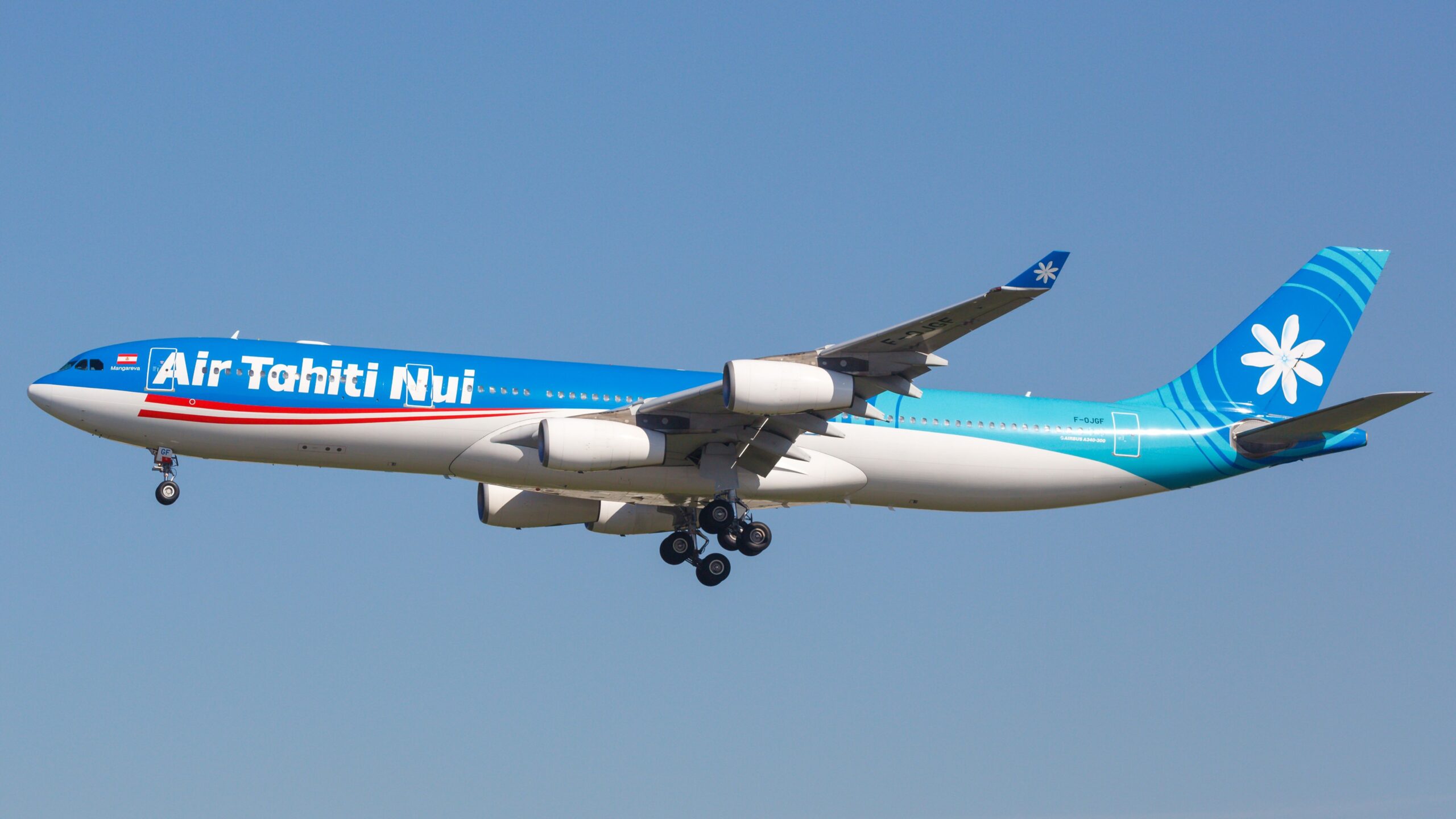French Polynesia’s remote location in the South Pacific Ocean means that long-haul aircraft are a must for its flag carrier, Air Tahiti Nui. While this airline has recently followed the industry trend of moving towards twin-engine widebody aircraft, it has also previously operated six quadjets from the Airbus A340 family. Let’s step back in time and take a closer look at Air Tahiti Nui’s relationship with the type.
A single A340-200
According to historical fleet data made available by ch-aviation, the six aircraft from the Airbus A340 series that Air Tahiti Nui operated over the years were split across two variants. That being said, this split was admittedly rather uneven, with just one aircraft belonging to the original A340-200 version, with the French Polynesian flag carrier receiving its only example of the Airbus A340-200 in November 1998.
Planespotters.net shows that it bore the registration F-OITN and the name Bora Bora. The aircraft was just over five years old at the time of its acquisition by Air Tahiti, having initially joined Air France in October 1993. The French Polynesian flag carrier fitted the quadjet with a 286-seat configuration, which mainly consisted of 250 economy seats. However, it also had a 36-seat business class cabin.
After four-and-a-half years, it left for Air Bourbon in May 2003. After just under two years at Air Bourbon, F-OITN then joined Spanish carrier Air Europa in April 2005. It then had a brief period of ownership at Airbus Financial Services, before joining Conviasa in March 2007. Apart from a two-month lease to Iran Air, it has stayed at the Venezuelan flag carrier ever since, but was placed into storage back in 2022.
Five A340-300s
Air Tahiti Nui’s remaining five aircraft from the Airbus A340 family were all examples of the larger A340-300 variant. These aircraft joined the carrier in the early to mid-2000s, with their arrivals spanning from December 2001 to June 2005. Four units had a two-class, 296-seat configuration (32 business and 264 economy), while the fifth had a six-seat first class cabin (alongside 24 business and 264 economy).

Related
Airbus A340-200 Vs A340-300: What Are The Differences?
The two quadjets were the first production variants of the Airbus A340 family to hit the market.
The four two-class aircraft came to the airline brand new, with some examples having not been taken up by Air Lib and Sabena. Meanwhile, the three-class A340-300 had spent its first four months at Canada 3000 Airlines, having joined this carrier in September 2001. As well as certain examples bearing registrations alluding to love, the sea, and the sun, all of these aircraft also bore names at Air Tahiti Nui:
- F-OJGF: Mangareva.
- F-OJTN: Bora Bora.
- F-OLOV: Nuku Hiva.
- F-OSEA: Rangiroa.
- F-OSUN: Moorea.
All in all, Air Tahiti Nui’s five examples of the Airbus A340-300 spent a much longer time serving the carrier than its single unit of the A340-200, with this period spanning almost two decades. However, their stories did eventually come to an end when the French Polynesian airline withdrew them in 2018 and 2019. One of the retirements was delayed, but its final A340 flight took place in September 2019.

Related
Air Tahiti Nui Operates Its Final Airbus A340 Flight
For the most part, these retirements represented the end of the line for Air Tahiti Nui’s five examples of the Airbus A340-300, with present data from ATDB.aero showing that four have either been scrapped or left in a derelict condition. However, F-OLOV remains active today as YA-KAA at private Afghan carrier Kam Air, having joined the airline from Air Senegal just over a year ago, back in May of 2023.
Usage snapshot
Given Air Tahiti Nui’s small fleet and remote hub location, the carrier has to pick and choose its routes. Looking at historical data from Cirium, an aviation analytics company, we can get a better idea of the sorts of corridors on which the airline used to deploy its widebody quadjets. Using 2018 (its last full year of A340 operations) as an example, we can see that it scheduled 1,948 flights with the type.
Photo: Markus Mainka | Shutterstock
Collectively, these services offered grand totals of 576,198 seats and 2,574,667,812 available seat miles. The top route connected Los Angeles International Airport (LAX) with Faa’a International Airport (PPT) in Papeete, Tahiti, peaking at 48 round trips with the Airbus A340 in August of 2018. Other important destinations that year for Air Tahiti Nui included Paris (CDG), Auckland (AKL), and Tokyo (NRT).
Air Tahiti Nui’s fleet today
Today, present data made available by ch-aviation shows that Air Tahiti Nui now operates a smaller fleet, which consists of four examples of the mid-sized Boeing 787-9 ‘Dreamliner.’ These highly efficient twinjets, which have 30 Poerava Business flatbeds in a 2-2-2 layout, 32 Moana Premium recliners in a 2-3-2 layout, and 232 Moana Economy seats in a 3-3-3 layout, are 5.3 years old on average.
Photo: Joe Kunzler | Simple Flying
Back in March 2020, when the world was just beginning to get to grips with the seriousness and scale of the onset of the coronavirus pandemic, Air Tahiti Nui used one of its Dreamliners to set a record for what was, at the time, the world’s longest-ever domestic flight. US travel restrictions forced the airline to fly directly from Papeete to Paris, covering the 15,715 km (8,200 NM) in 15 hours and 45 minutes.
Did you ever fly on one of Air Tahiti Nui’s Airbus A340s? Do you miss seeing them, or are you happy with the Boeing 787 as their replacement? Let us know your thoughts and experiences in the comments!





